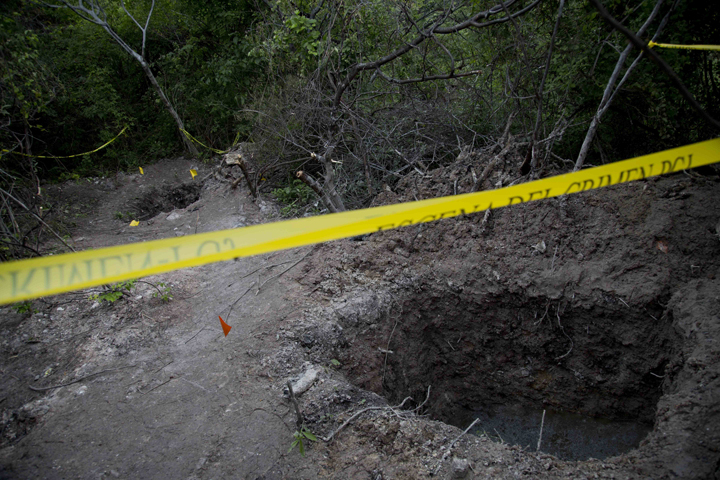CHILPANCINGO, Mexico – None of the 43 students missing since a confrontation with police in a southern city were among the 28 bodies found in the first set of mass graves outside that town, Mexico’s attorney general said Tuesday.

Jesus Murillo Karam said there are still no signs of the teachers college students who disappeared Sept. 26 after violent incidents blamed on police in the city of Iguala.
He also said 14 more police officers have been arrested and confessed to participating in the disappearance. The 14 are from the police force of Cocula, a town neighbouring Iguala.
Authorities have said police involved in “disappearing” the students were working in conjunction with a local drug gang.
READ MORE: Protests over missing Mexico students turn violent
An alleged leader of that drug gang, Guerreros Unidos, killed himself during a confrontation with Mexican security forces Tuesday, a day after protesters demanding an investigation into the students’ whereabouts burned government buildings in Chilpancingo, capital of the southern state of Guerrero.
Federal forces, which include federal police and military personnel, were carrying out an operation to capture Benjamin Mondragon, or “Benjamon,” the alleged head of the Guerreros Unidos gang in the neighbouring state of Morelos, when a gunfight broke out, a federal official said. The official, who was not authorized to be quoted by name, did not say which federal force had taken part in the confrontation.
Mondragon killed himself as he was about to be arrested, the official said, though he had no details on how.
The official said it was unclear whether Mondragon was involved in the students’ disappearances.
Guerreros Unidos allegedly had ties to the family of the mayor of Iguala. Police in Iguala killed six people in two incidents and carried off students before reportedly turning them over to gunmen working for the gang, authorities say.
One forensic expert who works with federal investigators says charred remains like those recovered at the first mass grave sites found outside Iguala can leave very little DNA for testing.
READ MORE: Some bodies found in mass grave do not match those missing: Mexico governor
“If a bone is burned at more than 300 degrees, it’s almost impossible to identify because the collagen is burned. Because of that, criminal organizations started to adopt that technique,” said Jorge Arturo Talavera, head of the bio-archaeology team at the Mexico’s National Institute of Anthropology and History.
He said the way the remains are exhumed also can affect identification. If they’re pulled out in a hurried manner, other identifying articles like jewelry or teeth get discarded.
Experts still are testing remains recovered from other mass burial sites found near Iguala, but they’ve given no information on what was found there.
On Tuesday, Guerrero Gov. Angel Aguirre said many of the bodies at the first site appeared to have been in the graves for some time, suggesting they belonged not to the students but to earlier victims of criminal gangs operating in the region.
“Some of these graves were not recently dug,” Aguirre told MVS radio. “Some of them are not recent, some are from months ago,” he said. Some of the bodies had been burned, making identification harder.
At least one detained gang member has said another Guerreros Unidos leader known as “El Chucky” had ordered him to kill 17 students.
READ MORE: Mexico captures Juarez Cartel leader Vicente Carrillo Fuentes
In a speech Tuesday, President Enrique Pena Nieto said the disappearances “are without doubt a topic that will lead the Mexican government at all levels to take actions that will prevent events like those in Iguala from ever occurring again.” He said the government “will strengthen institutions, especially those involved in law enforcement, so that they act with greater reliability and efficiency.”
Police are looking for the mayor of Iguala, Jose Luis Abarca, in order to question him. His wife’s brothers include two deceased top-level members of the gang, which split off from the Beltran Leyva cartel.
The gang controlled drug routes in Guerrero and Morelos.
On Tuesday, protesting teachers sprayed graffiti in support of the missing on bank buildings, a day after hundreds of students and teachers smashed windows at the Guerrero state capital building complex in Chilpancingo, 132 miles (212 kilometres) south of Mexico City, and set fire to some of the buildings.
Students from the school and local teachers blockaded the capital complex, pelting it with sticks, rocks and Molotov cocktails. The protesters are calling for the missing students to be returned alive, even though fears have grown that the mass graves could contain their bodies.
The finance secretary of Guerrero state said six buildings were affected.



Comments